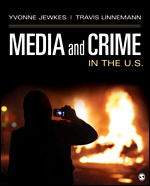Media and Crime in the U.S.
- Yvonne Jewkes - University of Bath, UK
- Travis Linnemann - Kansas State University, USA
The rise of mobile and social media means that everyday crime news is now more immediate, more visual, and more democratically produced than ever. Offering new and innovative ways of understanding the relationship between media and crime, Media and Crime in the U.S. critically examines the influence of media coverage of crimes on culture and identity in the United States and across the globe. With comprehensive coverage of the theories, research, and key issues, acclaimed author Yvonne Jewkes and award-winning professor Travis Linnemann have come together to shed light on some of the most troubling questions surrounding media and crime today.
The free open-access Student Study site at study.sagepub.com/jewkesus features web quizzes, web resources, and more.
Instructors, sign in at study.sagepub.com/jewkesus for additional resources!
“The comparative component to this book is brilliant. The eloquent writing style coupled with the international comparisons make for an informative, eye-opening, and exciting read! I honestly wasn’t sure what I would think about the comparative nature of this book, but I simply love it!”
“The comparison between the UK and US helps further our mission of creating global thinkers.”
“Accessible and engaging introductions to a wide range of theories, concepts, and critiques. Good use of illustrative examples (including a variety of great new US and contemporary examples).”
“This is the American version of the text I already use, and my students are primarily Americans. It is directly relatable to their experiences. This text offers foundational knowledge that links criminological theories and media theories with an examination of relevant current and historical events. Jewkes has made this material greatly relatable to an American audience while maintaining an international perspective.”
“The text is well written and articulates concepts in a clear manner. Chapters 2-4 present relevant real world examples that will allow students to draw connections between their own experiences/media exposure and course/text materials.”
“The chapter on crime news is unique to this text and spells out clear criteria for why some crimes get covered and not others. Chapter on Media Misogyny - always eye-opening for students. In Chapters 2 and 3, the social construction of the “other” is clearly illustrated.”
“The structure and topics covered are all encompassing. The additional features like the summary and key terms are very helpful. The writing is understandable and clear for the students.”
“Great examples. Goes beyond description to analysis. Applies more complex concepts ignored by other books.”
"Jewkes and Linnemann’s Media and Crime in the U.S. delivers even more than its title promises. It is certainly the go-to book for scholars and students seeking a critical, comprehensive, and theoretically rich analysis of the crime/media dynamics that percolate through everyday life in the United States. But more than this, the book invents a distinctive criminology for the 21st century – a criminology able to explore and understand the interconnections between popular culture, daily surveillance, digital identity, cyber-criminality, and other essential features of the contemporary."
"Jewkes and Linnemann have produced a definitive US companion to a classic in crime and media studies. In accessible, eloquent language, the authors provide us with a text that takes a much needed critical approach, ultimately insisting that scholars, our students, and general readers (re)conceptualize the relationship between media and crime in a manner in keeping with its proliferating spectacle."

 Sage College Publishing
Sage College Publishing


